Sunday 3rd September 2023

West Sussex County Council’s Book-A-Bus DRT gained a second zone three weeks ago covering villages north of Petworth. It’s been given route number ‘98 Flex’ to compliment route 99 (south of Petworth) which I blogged about at the beginning of last month.

98 Flex is a fully flexible DRT funded by the County Council’s Bus Service Improvement Plan, operated for West Sussex with a Mercedes minibus by Community Transport Sussex. The rural area covered (shown in green on the above online map but much more clearly in the printed leaflet below) stretches from Haslemere (in the north west corner) down to Midhurst (south west), Petworth (south) and almost to Billingshurst (east). Whilst those first first three locations are accessed, passengers wanting Billingshurst have to use something called ‘Billilinks’ – a shared taxi service operated by Jake’s Cars covering the east of the area.
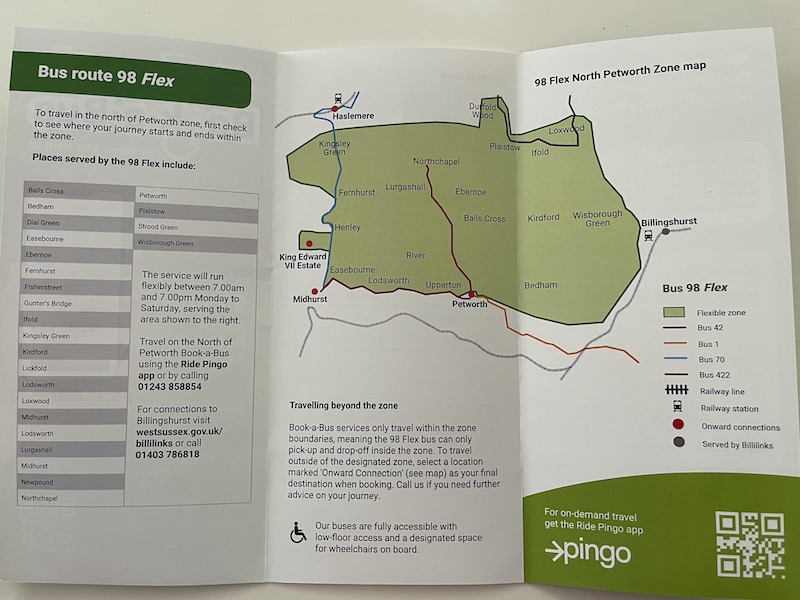
Confusingly Billingshurst is shown with a purple coloured dot on the online map (above), indicating rail connections, so I’m not sure if it’s included in Book-a-Bus or not. The key on the online map is also confusing as it doesn’t mention route 98 Flex, but does refer to route 99.
I booked a journey four days ahead of travel last Sunday to take me from the village of Kirdford to Petworth. My journey request for a departure at 14:30 on Thursday was accepted and I received the confirmation “Your ride is booked!” but also the rather unreassuring message “We will begin searching a ride for you 30 mins before your scheduled pick-up” adding “Please note that pre-booked requests are not guaranteed and depend on vehicle availability”.

Noting that caveat and with my extensive DRT travelling experience, I reckoned the phrase “Your ride is booked!” is as useful as the proverbial chocolate teapot. What would be more accurate is to say: “thanks for letting us know the journey you want to make in four days time but you might as well try again 30 minutes before you want to depart as that’s when the algorithm looks to see if the one bus which covers the vast rural area north of Petworth can get to you and take you where you want to go.”
If it turns out my neighbour booked the bus to take her to Haslemere station say 15 minutes before I want to leave to go to a doctor’s appointment in Petworth, then tough – I’ll have to make alternative arrangements at just half an hour’s notice. Try getting a taxi to reach you in an isolated village in that time.

Back to my actual booking …. Kirdford is a rather lovely village located five and a half miles west of Billingshurst. It’s been something of a bus desert having just a single off peak return shopping journey to Worthing on TF (route 69) and Horsham on MTh (route 64), both operated by Compass Bus.
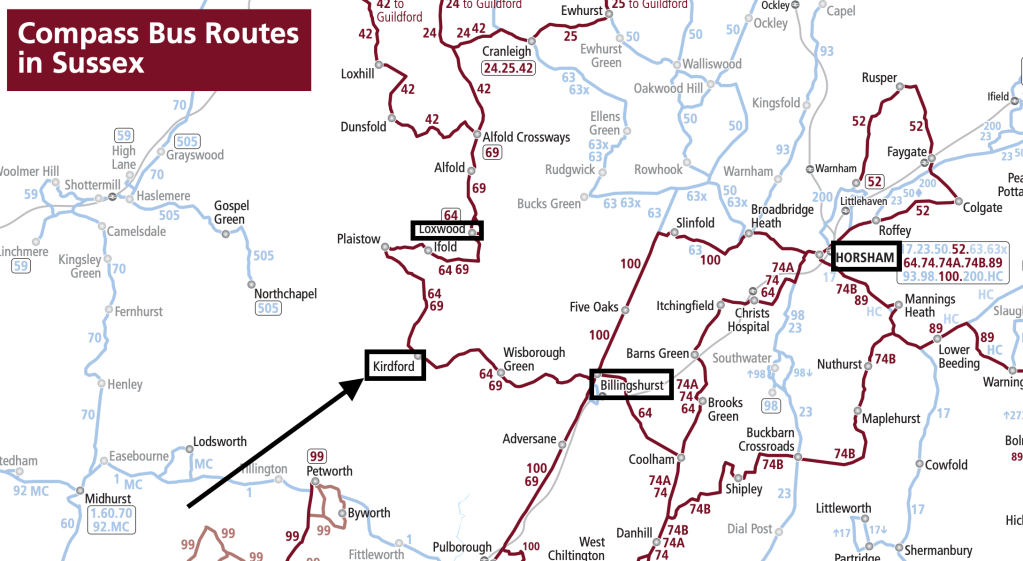
The Thursday journey back from Horsham arrives in the village at 14:06 on its way to Loxwood which I planned to catch, so a pick up at 14:30 on the 98 Flex was ideal.
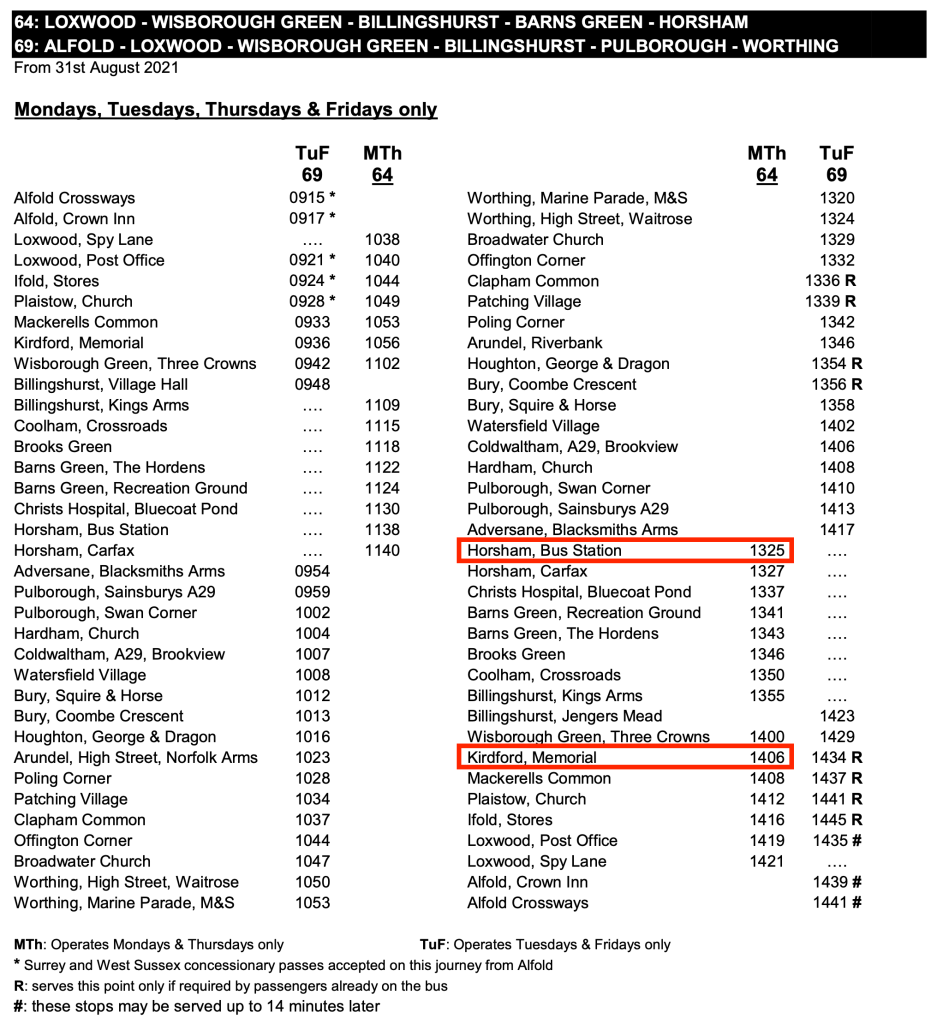
I commented last time on some inconsistencies with the Pingo app for Book-a-Bus and I see they’re still around.
Serious of all is the options it gives to use conventional bus and train services for your requested journey which appear above the Book-a-Bus option. For example when I booked my Kirdford to Petworth journey on Sunday morning at 09:14 it was showing a range of options including first up using the morning departures to Worthing or Horsham on shopping routes 64 and 69 implying I could catch those journeys on Sunday morning (note the “leave now”).

Nowhere does it explain this option only runs on a Monday, Tuesday, Thursday or Friday – the algorithm journey planner completely ignores that and assumes the journeys run daily.

Another shortcoming is having booked a ride, the confirmation in the app only states your destination, not your origin so you need to make sure you remember what it is – particularly pertinent when travelling back from somewhere to home, as you might forget where you’d booked the pick up.

Just to confuse things the time given alongside the destination you’re travelling to is your departure time from your origin point, which isn’t made clear.

I arrived at Horsham’s bus station on Thursday in good time and was impressed that 18 passengers, many with loaded shopping trolleys, boarded the 64 and we left spot on time at 13:25.

It’s a lovely rural ride through this part of West Sussex and we dropped many off as we passed through villages until there were about seven left on board when I alighted in Kirdford, soon after 14:00 to wait for my Book-a-Bus route 98 Flex pick up.

I’d been reassured my booking was going to happen by receiving two notifications, one after the other, at 14:00 advising firstly they’re “working on my request” (not very helpful) …
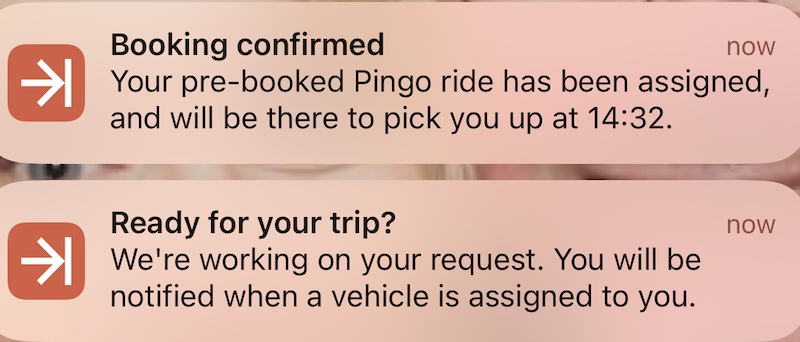
… followed more helpfully by confirmation my “pre-booked Pingo ride has been assigned”. Luckily I know what Pingo is, but it rather takes away from the Book-a-Bus branding to be told it’s a “Pingo ride”, and also what does “pre-booked” mean?
So with around half an hour to wait and the weather rather drizzly I sat in the bus shelter at the bus stop where the 64 had dropped me off heading towards Loxwood and it dawned on me no passengers ever board here and use the shelter as the four journeys a week bus heads towards a dead end type terminus from where you can’t return the same day.

However for me, on Thursday afternoon, it was a handy place to wait…… for one and a half hours. Let me explain.
As I was heading towards Kirdford on the 64 the map on the Pingo app helpfully showed me the minibus’s current location (just south of Fernhurst) and I guessed I’d soon see it move closer to me over the next 32 minutes.
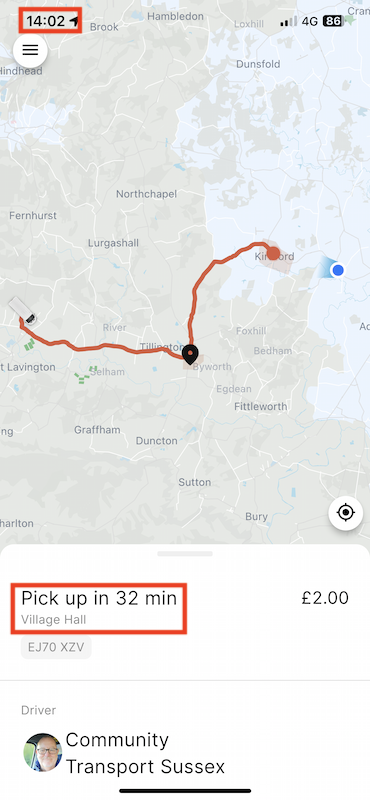
But I got a surprise next time I checked at 14:10 – the bus hadn’t moved at all, but the pick up was showing as being “in 1 minute”.

That intrigued me and bearing in mind the mobile signal was a bit dodgy with only one bar showing, I just concluded the map hadn’t updated and somehow the bus had got to me quicker than originally envisaged.
But as I kept my eyes peeled in the distance to spot the bus heading towards me, my confidence rapidly drained away as at 14:16 nothing had changed …

… nor at 14:20 by when the mobile signal had improved to two bars so made it even more odd that nothing was changing – the bus seemingly stuck south of Fernhurst, but still a long way from me, yet arriving in a minute.

And then, a couple of minutes later, this bombshell notification arrived on my home screen….

… which aside from the lie (there was no “high demand”) and the exclamation mark at the end, was somewhat unsettling realising I was now stranded in an isolated West Sussex village with the next bus not departing until 09:36 the following morning. I contemplated walking the five and a half miles to Billingshurst or ordering a shared taxi from Jake’s Cars, but before doing either of those, I reached out to Pingo via the “send us a message” icon on the app.
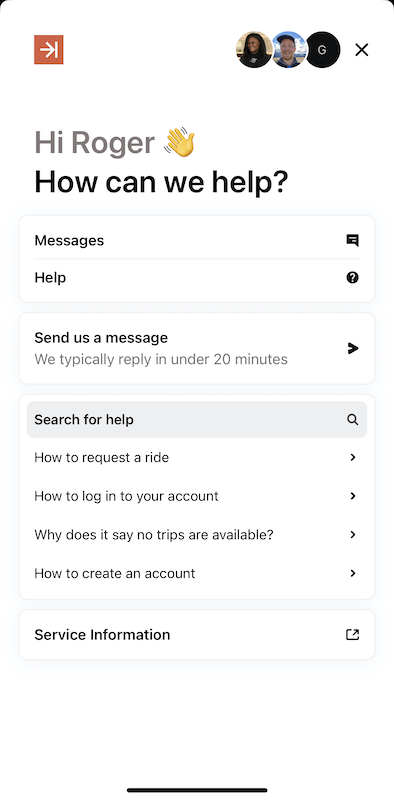
I didn’t keep a full screen-grab of my message to Pingo but you can see the ending of it and the reply from Guillermo who was probably in the United States.

I then received a phone call at 14:35 from Sam at Pingo who told me the bus was now on its way and would be with me by 15:00. And sure enough the app updated to show an arrival in 36 minutes (making for a 15:14 arrival).

I then received a phone call from Jan of Community Transport Sussex profusely apologising and saying they were on their way.
To cut this long story short …. I kept an eye on the app and for the next 50 minutes the bus seemed to be heading all over the place with expected pick up times varying up and down. It showed all the hallmarks of the Satnav telling the driver “do a u-turn” because the recommended route was not being followed.

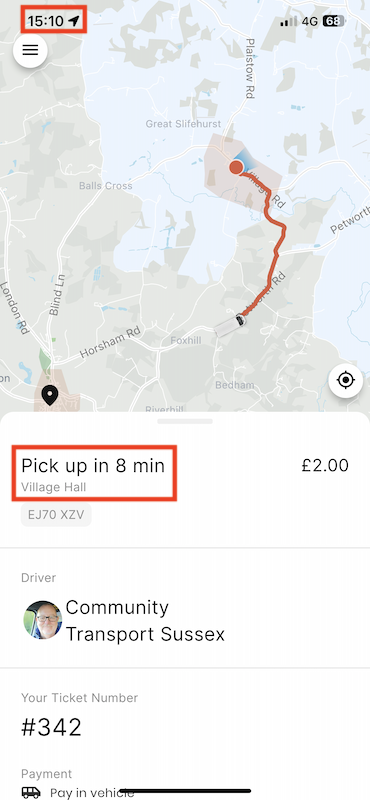



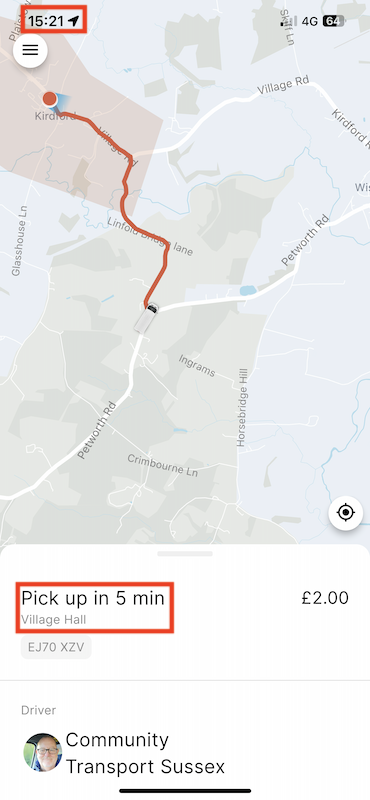
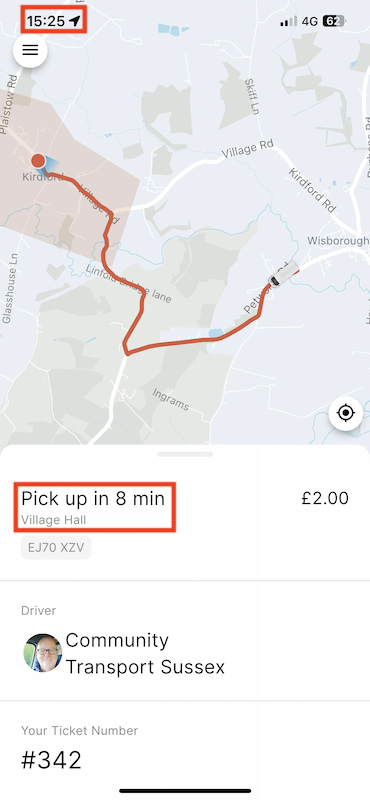

In frustration I gave Jan a call back and she reassured me they were definitely on their way.
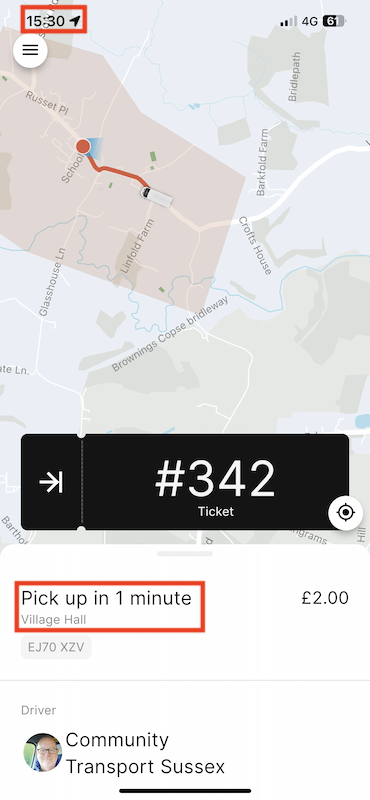
And the bus finally came into view at 15:31 … an hour and a half after I’d been dropped off by the 64, an hour later than the pick up had originally advised and half an hour after Sam gave me his updated eta.

If I’d had a doctor’s appointment or aiming to catch a train rather than just writing a blog, this experience would have put me off using Book-a-Bus ever again.
In the event Jan and Tim were both so apologetic they made up for the frustration of sitting in a bus shelter for an hour and a half. Both are drivers with Community Transport Sussex along with two other colleague drivers, dedicated to operating the 98 Flex. It was Tim’s first day out and I was going to be his first passenger and ironically Jan had volunteered to continue her shift beyond her scheduled 13:00 finish to make sure all went well for Tim!
Jan explained they were in Fernhurst when my ride request came through at 14:00 but all it stated was a pick up at “Village Hall” – just as that was all my pick up notifications stated (as you can see above). Without any village specified Jan and Tim assumed it meant Fernhurst Village Hall whereas I was sitting outside Kirdford Village Hall. I’m not sure why they didn’t see the tablet was presumably showing the route to take to reach me at Kirdford, but the upshot was they waited in Fernhurst for me and my guess is the software assumed I was a “no show” so the ride got cancelled and I received that notification.
I’m pleased I pursued the matter rather than undertake the walk to Billingshurst or call a taxi. It would certainly have been helpful to have had the name and phone number of the operator (Community Transport Sussex) added to the app so I didn’t need to message someone in the United States who are only able to deal with tech type app issues rather than operational matters and then only between certain hours and a potential wait time of up to 20 minutes for a reply.
Passengers using the app are not aware of the phone number they need to call if there are problems nor the name of the operator unless they have the leaflet. Due to the poor phone signal, connections to the Internet were not good.

I understand Community Transport Sussex have been provided with two minibuses for the 98 Flex with one currently acting as a spare although the Book-a-Bus website states it’s hoped to add another bus to operate in the zone soon, so I assume that will be the second bus.
I hope so, as running one DRT bus across such a large rural area won’t be much good once more people get to know about the service and want a journey to suit their needs “on demand”.
There’s a printed leaflet about the service which I’m guessing (and hope) is being/has been distributed around the area to raise awareness …
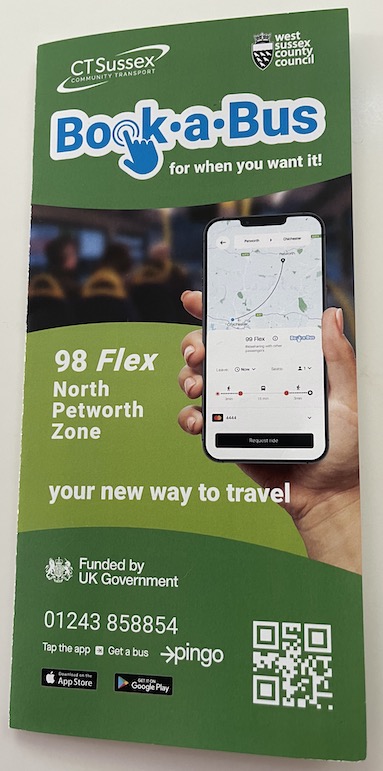
… and I also hope details will be added to bus stops in the area …

… and on Parish Council noticeboards.

It took us 15 minutes to reach Petworth and I bade my fond farewells to Jan and Tim being grateful they did finally get to me.

After the last three Sundays of positive DRT blog coverage I’m sorry to conclude on a negative tone, but it’s blatantly clear this is another trial scheme with absolutely no chance of continuing once the BSIP money runs out. Residents and visitors in this new zone need to make use of it while they can and the funding is available. Jan told me of one passenger with a concessionary pass who’s already delighted at saving £20 per journey in taxi fares
One positive to end with … I know both Pingo and West Sussex County Council officers will be reading this report and have told me they aim to make improvements and learn from feedback which is good to hear.

Finally for today, I see the DfT are holding a “Launch of the monitoring and evaluation interim report on the Rural Mobility Fund DRT pilots” in Nottingham on 19th September between 10:00 and 16:00 at which “operators, tech providers, local authorities and community transport operators, third sector and representative bodies will be present”. Interestingly “the passenger” doesn’t seem to get a look in. The report will certainly make for interesting reading – particularly the sections marked “value for money” and “prospects for sustainability”. I look forward to reporting on the report later this month.

In the meantime this concludes my Summer Sunday weekly DRT blog extras but fear not, there’s still more DRT schemes to check out including a new one in West Cheshire which slipped in under the radar last month and another in East Lothian (route 109) as well as two more expected soon in Aylesbury and Shropshire, so the occasional Sunday DRT blog extra will continue through the autumn and winter.
Roger French
Blogging timetable: 06:00 TThS
Until WordPress can sort out the bug requiring those adding comments to register rather than just add their name/identifier and email address (which isn’t published) as used to happen, I’ve changed the settings to accept anonymised comments but the voluntary inclusion of a name/identifier with each comment either at the beginning or end would be appreciated.

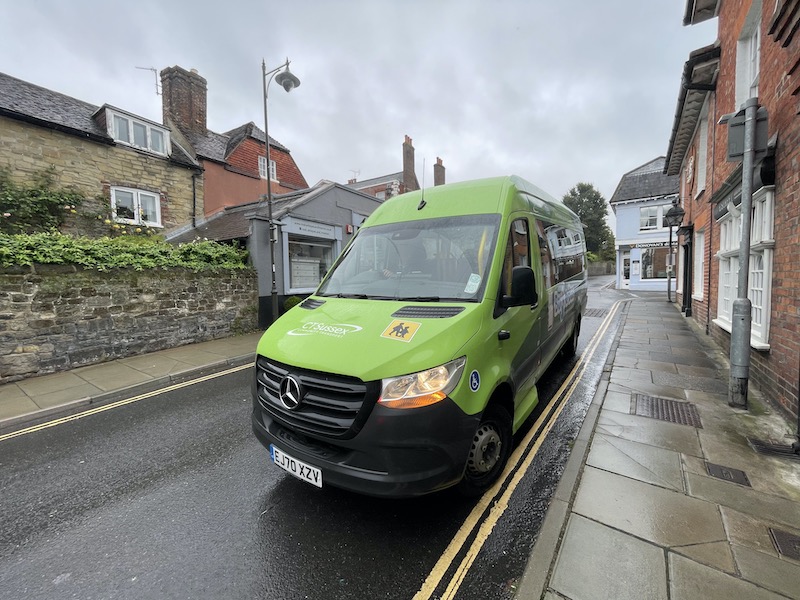
It’s a great pity they have not asked Roger to present at the conference as I’m sure he knows more about the DRT empire slowly being constructed by the Dft than anyone else who will be present.
Because none of them actually define what success( or failure) is no doubt the whole exercise will be hailed as a success.
I’m also willing to bet a lot of these schemes will continue to be funded as the embarrassment of the Government/Dft at ending them would be too much to bear, despite their abysmal economics and generally low usage.
LikeLiked by 2 people
How frieghtening for what could have been an elderly prospective passenger to be left at a bus stop, and that it is expected that everyone is able to even work an app! I doubt many would have persevered and would have just gone for the taxi which would have meant that would be the end of trying for that bus again. Some of these new formats are all app based none of the old fashions dail a ride type where like a real taxi service too you speak to a real operator. So much funding for services by the government being thrown about yet the quality of the actual service and linking services as you described are awful and far too technical. Always a good read these blogs. Glad you eventually got back to base safely that same day.
LikeLiked by 2 people
But will Roger be allowed to attend the launch of the report? As a mere passenger (no offence intended!) does he qualify? Or will he have to blag his way in under Leon’s coat??
Such excitment to look forward to!!
LikeLiked by 2 people
My heart always sinks when you realise that a bus travel experience would reinforce the negative stereotypes that so many people still have and put off a real prospective passenger for life. Having said that, I guess it’s most likely that someone requesting a ride in a rural village would just walk home rather than be stranded.
With the apps being so poorly designed and passenger numbers on the typical scheme being so low, I do wonder whether whether a phone-in only scheme would be more effective, better received and better value in most cases.
LikeLiked by 2 people
Not always feasible with frequently no footpaths and no street lighting so not exactly safe and many users are likely to be elderly and I don’t think they will be walking 3 or 4 miles carrying heavy shopping as well
LikeLike
People aren’t going to use these services more than once if they’re not reliable!
LikeLike
Really, one doesn’t know whether to laugh or cry! Thank you anyway for the impressive lengths to which you are prepared to go to keep us entertained on Sundays, and to hammer home your point about the unsustainability of DRT as per these ‘pilot’ schemes – presumably as recommended by the less than wholly impartial consultants who, as ever, swarm like wasps around the jam-pot of government money.
The presented reason for all these trial schemes is – I presume – to see if there is a less expensive and/or more popular way to service the transport needs of rural car-less constituents. I wonder if anyone has researched the level of fixed-route bus provision which would require the least subsidy: maybe in some cases an hourly service throughout the day, intelligently linked in with rail etc. so as to provide the best extent of travel opportunities, might call for less government money than three buses a day on Tuesdays and Fridays. That might be a ‘pilot’ worth trying out!
Kirdford is a lovely village which, in my memory, used to have five buses a day linking it with Petworth and Billingshurst. It seems that Compass are able to run a once-a-day twice-a-week shopping service which is well used. Perhaps one cheap option to go forward would be for W.Sussex council to talk to the company and its regular drivers, who probably have better ideas than a less-than-totally-satisfactory app-developer in the USA …
Rick Townend
LikeLiked by 2 people
Couldn’t agree more Rick. Spot on.
LikeLike
One of the biggest problem in my view is these schemes are set up by people who in most cases have never set foot on a bus and almost invariably the customers (passengers ) are never consulted
LikeLike
“I wonder if anyone has researched the level of fixed-route bus provision which would require the least subsidy: maybe in some cases an hourly service throughout the day, intelligently linked in with rail etc. so as to provide the best extent of travel opportunities, might call for less government money than three buses a day on Tuesdays and Fridays. That might be a ‘pilot’ worth trying out!”
I agree, and all that the DfT needs to do is to read this report to see what should be trialled. I believe the Welsh Government has referenced the Swiss approach in its plans for their bus network.
https://www.sciencedirect.com/science/article/pii/S0967070X16301469
LikeLike
Extract from above:
“The overall effect of the Lower Engadine’s coordinated network is that passengers can navigate the system’s main lines throughout daylight hours without consulting a timetable. Users only need to know the ‘minutes-past-the-hour’ that a service departs from their local stop, and once having boarded are offered quick connections to almost any destination across the regional (and national) public transport network. Visitors arriving in the region by train will also typically find their local bus connection waiting at the station.”
LikeLike
The agenda at the conference should also include a session on ‘how do we extricate ourselves from this mess?’
I assume reps from the app companies (who stand to profit most) will be there, but not the poor passenger. Shortsightedness does not come anywhere close. Maybe it’s time the National Audit Office was called in to give a Value for Money report on this public expenditure.
LikeLiked by 1 person
In most cases from the scant information publicly available the costs are very high and the passenger number very low and service availability and reliability is poor. The usual response to a failing DRT service is to expand the service area which just make a bad situation even worse
The apps are complex and difficult to use and are simply not reliable and in most cases not really fit for purpose in spite of costing a small fortune
Trying to contact a DRT service can be difficult and confusing
You cannot be sure of getting a trip when you need it nor can you be sure of getting where you need to be a the time you need to be there
Basically DRT does not work. A few people may use them out of lack of any alternative but it will never amount to any significant numbers as demonstrated by the something like 80% plus failure rate of DRT schemes. Some of these DRT type schemes have managed to rack up loses of over £50 a trip
Do they even analyse the detailed trip data they should have. It may enable sensible fixed timetable routes to be set up as it will give very detailed information on travel patterns
LikeLike
I recently tried to book a mid-morning journey on Mole Valley Connect from Leatherhead railway station to the National Trust’s Polesden Lacey giving 24 hours notice. Previously a visit by public transport had entailed a 1 1/2 mile walk from the nearest bus stop. The earliest time I was given was about 13.45. I learnt the need to book well in advance but at least it indicates this DRT for one is popular.
JohnC
LikeLike
I think Rick Townend has pretty much summarised the situation . . . how best to solve the rural transport problem. Can I turn the question around . . . what exactly IS the “problem”?
Are we trying to solve a problem that isn’t there? Are we trying to give rural residents too much choice? If we accept that most rural dwellers will have access to a car for work, and therefore will have a car for leisure / shopping travel, then we should be catering for that small number who actually NEED transport, and provide for THEIR needs.
We will never persuade people away from their car . . . that just ain’t never gonna happen!!
A [once-twice-every weekday] bus service serving a multiplicity of villages and giving 2-3 hours in the local market town would serve many, if not most, passenger needs. A service that runs both morning and afternoon gives even more choice.
We can all point to other routes similar to the Compass 64, and 18 passengers is a good load, especially considering all the shopping trolleys!! Shopping, library, dentist, doctor can all be fitted in during that period, and if the bus runs more than once-weekly, more choice is available.
Evening entertainment in towns is now usually restricted to eating out . . . few have cinemas / theatres now, and if they do, a taxi is more suitable . . . no waiting an hour for the 2300 last bus! The latest crop of DRTs seem to be concentrating on the 0700-1900 period anyway.
How many of that 18 passengers would have used a DRT? Bearing in mind the atrocious performance of most of the app-based schemes tried out by Roger . . . how many hours would it have taken to convey them all on a 8 seater minibus?
This blog post should be held up, like all the others, at the “launch” as evidence of the failure of DRT.
LikeLike
Something else which is missed by the DRT-istas is that the once-a-week shopping buses they too often replace are social occasions as much as they are shopping trips. For a good proportion of the regulars the trip is their chance to meet up with friends and acquaintances from other villages, have a good gossip and generally just socialise.
I’ve seen this time and again when I’ve caught once-a-week services as part of one of my own trips, yet it’s something which is given zero consideration by planners with their “turn the bus into a taxi” mindset.
LikeLike
A service serving *villages* north of Petworth and the pick up is ‘village hall’, no chance of confusion there then. Similarly I would want to avoid stops called ‘church’, ‘church road’, ‘the street’, ‘post box’ (I would have added ‘village shop’ but that might actually be pretty unique). Surely each stop could begin with the first 3 or 4 letters of the village name (provided that is unique – I realise that that there might be clashes, the closest I could come up with is Northchapel and North Heath but the latter just seems to consist of trees, in which case a variant so NHea for the latter). It just involves putting more thought into planning!
LikeLike
The full post code normally defines a pretty small area and can be fully defined if you give a full post code and house number
LikeLike
I suppose the one bright side is there was a bus shelter to wait in. In most rural areas you would be stuck in pouring rain for an hour and half
LikeLike
I agree wIth you but there is the added complication of free bus passes where people complain to their local councillor that these are useless because there is no service, bus does not run when they want it, runs to wrong destination etc.
Here in Scotland there is further pressure due to the introduction of free travel for under 22s. I understand that this age group is a sizeable proportion of users of the Berwickshire Pingo which probably explains why the scheme has recently had its hours increased to finish at 10pm.
LikeLike
I see that the local cab firm is down £20 a month thanks to competition from a Government subsidised taxi operation. Perhaps it would be simpler, cheaper (to the taxpayer) and retain more money in the local economy if they just got the cab company to pick up the rides and subsidise them instead? Not as sexy of course.
Paul B
LikeLike
Feels like a FoI request to get hold of all those conference papers might be worth a try.
LikeLike
Hi Roger
Part of the problem with identifying bus stops is down to the councils not giving a lot of thought. Take a stop that we have on Compass’s 85 route that is simply called “the Island” when a village identifier would make it a lot clearer. i.e. Westergate the Island makes it clear where it is.
LikeLike
What is the definition of a successful DRT service
How do they verify the service meet the needs of potential
what is the maximum subsidy per passenger that would be acceptable
LikeLike
That “village hall” bus stop identifier shows up a problem which I’ve found is universal in England on any journey planners that include bus stops – thousands of identical names all over the country that don’t include the community name. You’d never find that in Germany – every station and every Haltestelle has the local community or city name as the first element. Given that every bus-stop in England has it’s own alphabetic code, the solution is already there in that a computer system can match the code to the community with ease. It just needs someone who knows about public transport to put the information together!
LikeLike
Yes, the publicly available NaPTAN record includes all necessary geographic and naming identifiers for every stop.
LikeLike
Spot-on comments by Greenline727 and A Nony Mouse. The weekly bus trip is the highlight for some isolated rural dwellers and I have lost count of the times a journey for me has been brightened by the latest village gossip. DRT in almost all cases is merely duplicating at great extra cost what the local taxi provider could do, and the public transport departments of local Councils should be travelling this avenue if the restoration of a fixed service really cannot be entertained.
Presumably, this latest “toy” was the excuse for withdrawing the weekday service on Compass 42 from Plaistow, Ifold and Loxwood, the latter village containing substantial housing.
LikeLike
You make an interesting point about taxis. Always a great option. Sadly taxi operators are thin on the ground in some rural areas and can be very difficult to contract with. Stating facts that’s all. While can be an excellent solution it’s not a one size fits all. And as far as the 42 is concerned I guess that’s a West Sussex CC question – but always great to “blame” DDRT isn’t it
LikeLike
One problem highlighted in this post is the poor mobile phone signal. That must be a further disincentive to book DRT and track the progress of your booking. Given how densely populated southern England is it’s pretty disappointing.
LikeLiked by 1 person
Also a problem for the mobile network dependant tech on the bus as well. South downs and weald not renowned for its network coverage
LikeLike
The DRTs keep coming! ££££s for the tech companies.
https://www.bbc.co.uk/news/uk-england-surrey-66684463
LikeLike
I was sorry but not surprised to read Rogers story from Kirdford. Quite apart fro, the fact that many people are unwilling or unable to cope,with all these complicated apps, most of them don’t work properly, as Roger had discovered more than once.
The recently introduced WESTlink in also,reset has over 20 vehicles circulating all day, I have been trying to book a trip on it since it was introduced, and have not succeeded once, always being told “No ride available.”
The only one I have succeeded with is the Cotswold Robin, which has on the seven occasions I have used it met me off the bus in Bourton on the Walter and taken me to a remote village to start my walk,…a personal taxi, But I wouldn’t dare use it to get back at the end of the walk..I always walk back to the main bus route.
Semi flexible routes can work, and I have successfully used the 99, the Pewsey to Devizes route and the one on the north of t(e Isle of Man, all of which Roger has described. but DRT services will never work, and are a total waste of money which would be better spent maintaining proper bus services
LikeLike
The above was posted by Peter Cowlyn in Wells
LikeLike
There’s some absolutely terrible backup tech at work there – why is it showing you pickup in 1 minute when it can “see” that the bus is 30-40 minutes away from where it knows you are (because of the information in your booking)? Why, by the same token, isn’t it urgently alerting the driver that he’s got a pickup 40 minutes away and here’s the route to it?? It shouldn’t matter what the stops are called if the system knows where they are and can just satnav the bus to them – or at least plonk a big pin on the driver’s map with a “you need to be here in x minutes” message. Just terrible system design and implementation all round, in my professional opinion (over 40 years as a system designer and programmer!).
LikeLike
Reply to Peter Brown (higher up) – very many thanks for the link to the research article [Watching the Swiss] – as you say, some welcome facts about how how an integrated Taktfahrplan, with sensible frequencies, actually does work in a rural situation. Certainly many people living in country areas do have cars; in the UK, it’s often a necessity – even if only to get to the station! But owning/maintaining/insuring/taxing/fuelling/garaging/parking/learning-to-drive a car is not cheap. Some people see their car as a status symbol or object of beauty; however, many of the new generation [and me too] would gladly do without it **IF** they could get where they need/want to go by bus and train. And the Swiss have shown that can be done.
How about a pilot in a rural area? – maybe East Kent: Stgecoach have not done badly with the buses. But there is little co-ordination with trains.
Rick Townend
LikeLike